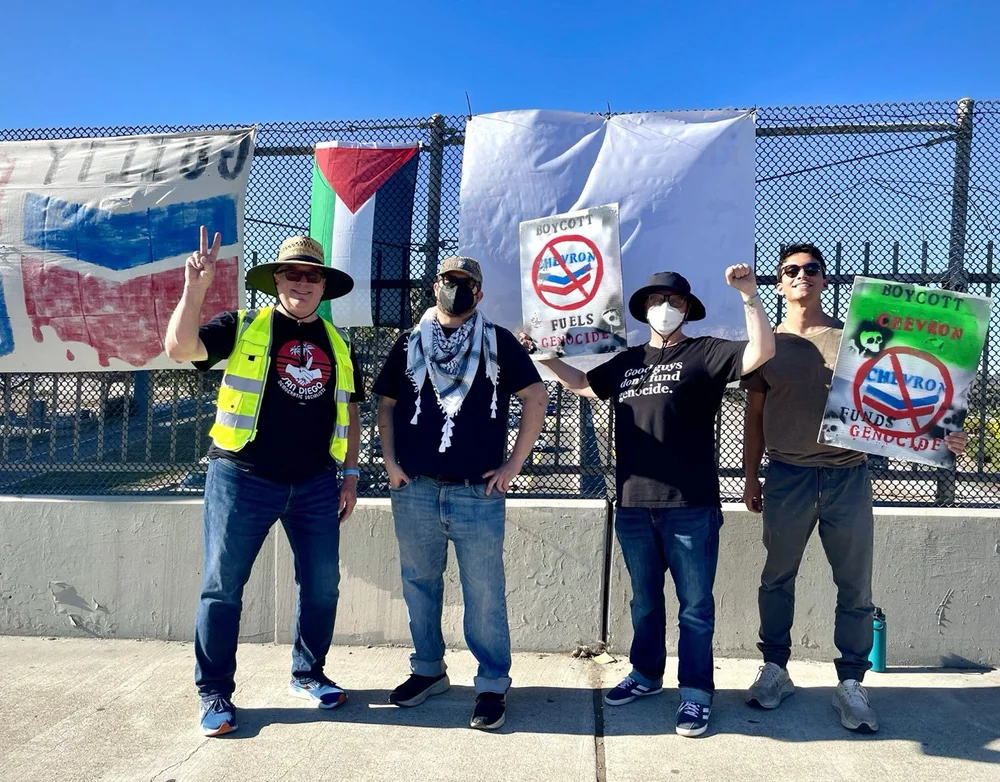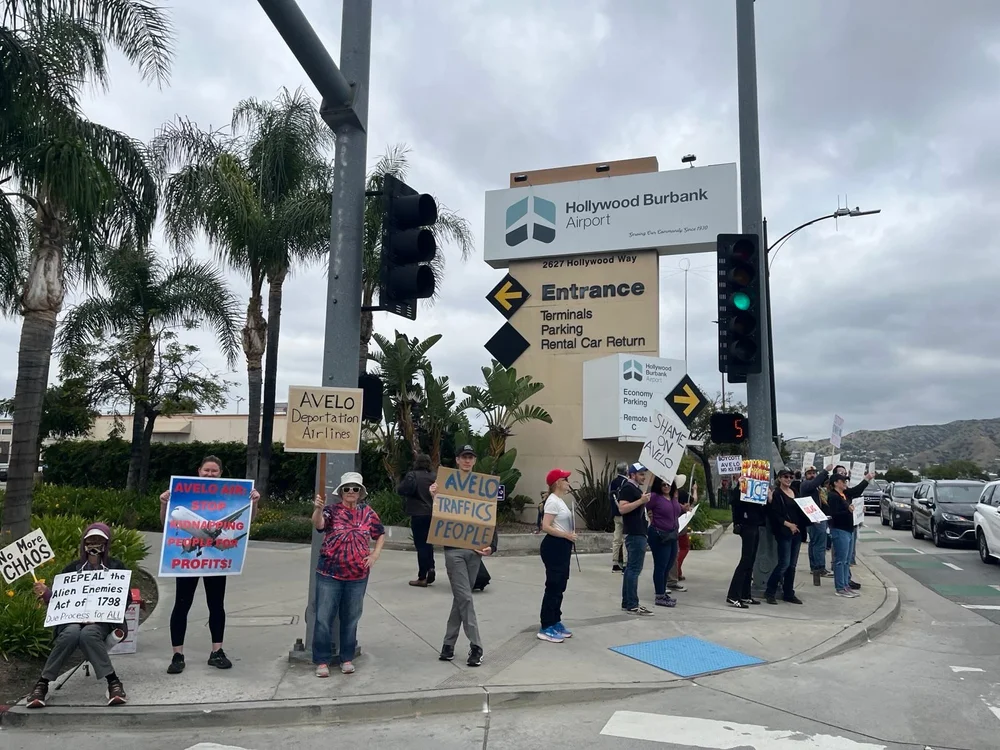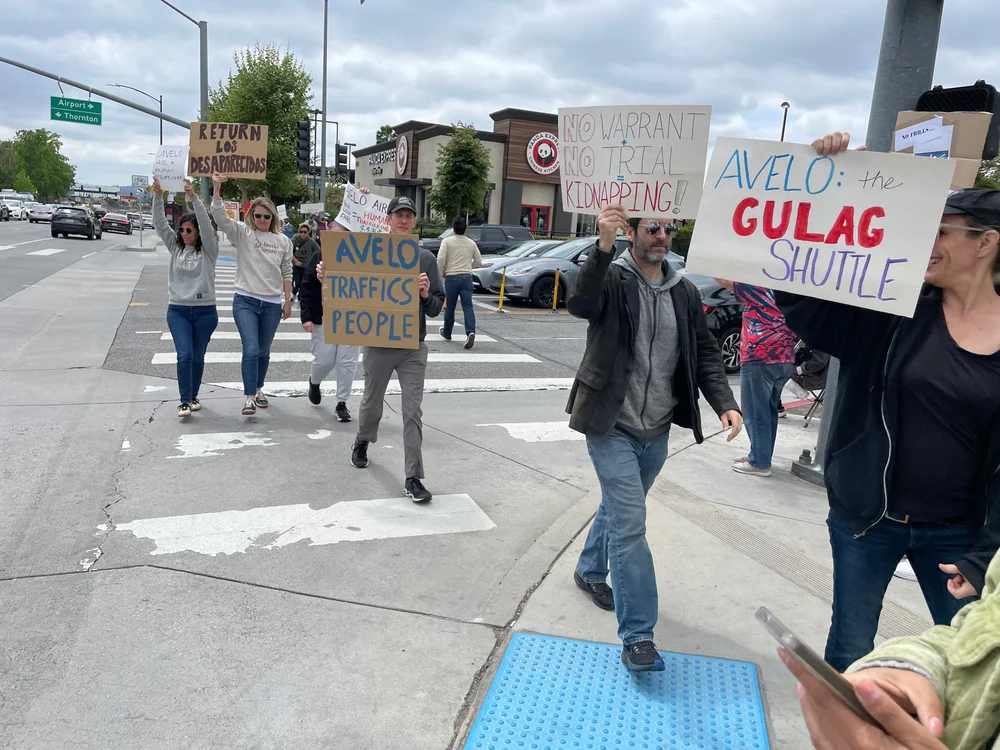


Get Up, Get Excited, Get Organized with MADSA!
After an action packed September General Meeting, two important shout-outs are in order:
First, we voted to kickstart a No Appetite for Apartheid Campaign here in Madison. No Appetite for Apartheid is a DSA National campaign launched by the Palestine Solidarity Working Group to pressure grocery stores to become Apartheid Free Stores by dropping companies and products that participate in Israeli apartheid and theft of Palestinian land. The campaign is powered by a number of chapters and coalitions across the country, and the Madison Area chapter will now be engaging in that work as well! As socialists, we stand in solidarity with all those facing settler-colonialism, and as Americans it is our duty to work from within the empire to end American imperialist violence around the world. At the September General Meeting, the chapter voted overwhelmingly to reaffirm this commitment by being the force for change in our own city. We look forward to an apartheid free Madison – and we need your help to get there. To get involved in this important work, join the #palestine-solidarity channel on Slack, check the chapter calendar for upcoming No Appetite for Apartheid (NA4A) planning meetings and events, and read more about the national campaign here.
Second, we voted to charter an Electoral Working Group to formalize the work already being done by the Power Mapping Committee as we prepare for local elections and work towards a statewide electoral strategy. If electoral work is your jam, you’ll definitely want to check out an upcoming EWG meeting, help canvas our neighborhoods with your MADSA comrades, and mark your calendars for the members-only town hall with Rep. Hong on September 29. Why a town hall with Rep. Hong? Well if you haven’t heard, Francesca Hong – a MADSA member and endorsed state legislator – is running for governor! We are excited to see where this campaign goes and to working with Fran on building the democratic socialist movement in Wisconsin. To that end, we must now engage in the process of democratically deciding if and how to get involved in the gubernatorial race. The town hall will be the first step in this process, where members will have the opportunity to ask Fran any and all questions – so don’t miss out! If you’re not yet a member, join DSA today to be able to attend.
If all that isn’t enough action for you, we have so many more exciting events and opportunities to get involved in our growing movement for a better city, state, country, and world, so get your calendars out and read on for all the details.
In this newsletter:
- Thu. September 25, 6-8:00pm: Beyond the Two Party System: A Socialist Way Forward
- Sat. September 27, 10:00am-12:00pm: Coffee with Comrades!
- Sun. September 28, 11:00am-12:30pm: Wretched of the Earth Reading Group
- Mon. September 29, 6:30pm: Members-Only Town Hall with Rep. Francesca Hong
- Sat. October 4, 2-3:30pm: October New Member Orientation
- Tue. October 7, 6:30pm: Copaganda Book Talk with Author Alec Karakatsanis
- Sun. October 12, 5-9:00pm: Halloween Carnival & Queer Liberation March Fundraiser
- Wed. October 15, 6:30-8:30pm: October General Membership Meeting


We Caught the Bus! Retaking Bay Area Public Transit

Peninsula DSA organizers rallied on July 1 at Millbrae Transit Center with riders and advocates from Transbay Coalition, Seamless Bay Area, Faith in Action Bay Area, Silicon Valley Bike Coalition, Housing Leadership Council of San Mateo County, 350 Silicon Valley and Sustainable San Mateo County to demand the decision-makers at SamTrans "opt in" San Mateo County to the regional transit funding measure (Wiener & Arreguín's SB 63). Photo, Vallery Lancey
San Mateo County Opts In to Regional Funding Measure
Follow-up to Get on the Bus: Retaking Bay Area Public Transit
Bay Area public transit notched a generational win for operational funding thanks to grassroots organizers and transit advocates. Throughout 2025, Peninsula DSA (PDSA) in suburban San Mateo County engaged transit riders and activists to save light rail Bay Area Rapid Transit (BART, 178,000 weekday riders) and commuter rail Caltrain (37,000 weekday riders) from looming fiscal cliffs and severe service cuts.
In partnership with Transbay Coalition, PDSA organizers reached people via many channels, including PDSA’s social media; flyering BART and Caltrain stations and talking to riders; posting to r/BART and r/Caltrain on Reddit; mobilizing PDSA chapter members via email, text messages, and our own Discord server; and a successful coalition rally during rush hour at a major transit hub in Millbrae. Our underlying message to transit riders? Demand San Mateo County opt in to SB 63!
PDSA identified SB 63, Senator Scott Weiner (District 11) and Senator Jesse Arreguín (District 7)’s 2026 five-county regional funding measure, as a priority campaign for our chapter. The Senate bill authorizes a 2026 citizens ballot initiative campaign to raise new funds to sustain BART, Caltrain, Muni (San Francisco), and other transit agencies in the Bay Area as they continue to recover their pre-COVID ridership. The tens of millions of dollars in new dedicated revenue would save these fixed-rail operators from massive service cuts that would render them virtually unusable.
The importance of maximum funding
But of course there’s a catch: Politicians chose to give both Santa Clara County and San Mateo County, the two wealthiest counties of the five, the option to decline to participate in the group project or opt in at a lower tax rate than the other three counties. Transit riders like us immediately understood exactly how important it is to get maximum funding for our county, which relies on Caltrain for more than just Giants games and has six BART stations, including an essential stop at San Francisco International Airport (SFO).
But transit riders aren’t the decision makers in San Mateo County. That’d be SamTrans, the county-wide bus system, or more specifically, the nine members of the Board of Directors. To save BART and Caltrain, PDSA members and allies attended the monthly SamTrans Board of Directors meetings to push them to think beyond San Mateo County’s borders and invest in regional transit for the people through SB 63. Our consistent pressure tactic—whether in person, via Zoom, or by email—was making well-coordinated public comments in support of opting in to a progressively funded regional funding measure.
Comrades and allies used our time at the podium to share personal transit stories and educate the Board members, most of whom never use transit, on how transit cuts would negatively impact local SamTrans riders and San Mateo County residents. We also took the opportunity to push for funding SB 63 with a gross receipts tax (0.112% tax on the top 2% of businesses) instead of a regular regressive sales tax (of ¼ or ½ cent) that would hit low-income SamTrans riders the hardest.
Final Showdown with SamTrans
The August 6 SamTrans Board meeting, when the Directors voted on SB 63, was highly unusual. Chair Jeff Gee refused to hear or discuss any public comments focused on the gross receipts tax, despite the hundreds of emails on that topic that we had encouraged transit riders to send to the Board of Supervisors and other influential political bodies. PDSA member Marc S used his public comment to gesture to gross receipts anyway: “The proposed sales tax, compared to other tax options, might not even prevent all cuts. Participating in SB 63 today is the bare minimum [to] address the San Mateo County residents' need for affordable, safe, and equitable transit both within the county and around the Bay Area.”
In the eleventh hour, California Assemblymember Diane Papan was given the floor and used her time to advertise her own overreaching amendment to SB 63 that called for “accountability” regarding how other counties would spend the funds at their transit agencies, while repeating misinformation about how BART operates and railing against “taxation without representation”—the Boston Tea Party was mentioned. (Note: San Mateo County would already have a seat on BART’s Board of Directors, and the vote and oversight Papan desires, if politicians hadn’t opted out of the network in the 1960s!) “The fiscally conservative rhetoric came from the fact that none of these board members seem to know there are citizens of San Mateo County who rely on transit to get around,” said Becca W, a PDSA member who publicly commented. “But now with this public pressure, they are well aware.”
Even so, PDSA’s s organizing efforts paid off. The SamTrans Board voted 8-1 to opt in to SB 63 to raise new revenue to fund the transit agencies in the five-county Bay Area: Alameda, Contra Costa, San Mateo, Santa Clara, and San Francisco. (The one dissenting vote was Jackie Speier.) SamTrans opted in at the higher ½ cent sales tax rate, a huge win considering they had been leaning toward opting out of the measure before our campaign kicked into gear. The public records of their official correspondence shows SamTrans received more than a hundred emailed public comments specifically in support of SB 63, exceeding their average inbox haul by a factor of ten.
Coordinated Public Transit Is the Way Forward
Assuming the citizens’ ballot measure is approved by a simple majority of voters in November 2026, the five-county Bay Area will have a new shared revenue source for maintaining current levels of service for public transit. Because Bay Area residents and visitors cross county borders all the time, it only makes sense that we plan and fund projects together. Robust public transit networks will be key in building a green future where a polluting private car is no longer the only viable option for getting around San Mateo County.
Of course, with inflation and tariffs, even more money will be necessary if transit operators are to deliver faster, rider-friendly, affordable, and coordinated service around the region. Though the gross receipts tax didn’t make it into the final bill, keeping Bay Area transit operational with an assist from wealthy San Mateo County allows PDSA organizers the space and time to plan our next strategic move to win better (and eventually free!) transit for all.

Transit coalition poster for July 1st Rally to Save BART & Caltrain in San Mateo County.


Banners Across the West Coast Call Out Chevron’s Ties to Genocide and Climate Change

Banners on Berkeley overpass. Photo, Leon Kunstenaar
Coordinated banner drops at 25+ sites escalate DSA boycott targeting Chevron’s Israel portfolio
DSA chapters from Seattle to San Diego joined dozens of autonomous pro-Palestine and Climate Justice groups on August 29 to stage a coordinated banner drop at more than 25 locations across the West Coast. The action grew out of the escalating boycott of Chevron, linking everyday fuel purchases to the company’s role in enabling human rights abuses in Gaza.
“The genocide in Gaza involves many actors,” said Tim Husarik, a San Diego DSA member. “Chevron is among the most complicit—profiting from destruction—so building support for boycott, divestment, and sanctions is essential in the imperial core.”

Comrades on overpass in San Diego
The banner drop
Chapters unfurled banners and handed out flyers urging neighbors to join the boycott and to ask Chevron franchise owners to press corporate leadership to end business in Israel. Local actions were autonomous, but timing and messaging were coordinated to maximize visibility and underscore a sustained, multi-chapter campaign. “The banner drop was a good tactic,” said Bonnie Lockhart, an East Bay DSA member. “Small groups could pull it off with a few people, and larger groups could span multiple sites or draw a crowd on an overpass to create drama and space to plan next steps.” These banner drops are part of the broader #StopFuelingGenocide campaign, of which our national DSA International Committee is a leading coalition member. The coalition has staged protests in more than 20 U.S. cities at Chevron gas stations, refineries, and corporate offices. At stations, volunteers have asked drivers to fill up elsewhere and sign the boycott pledge—an effort that has drawn tens of thousands of consumer commitments since launch.
Why Chevron and why now
According to the American Friends Service Committee, after acquiring Noble Energy in 2020, Chevron became the operator of the Tamar field and a major partner at Leviathan, making it Israel’s largest natural gas producer. In 2023, the company earned an estimated $1.5 billion from these projects while Israel collected roughly $820 million in royalties and fees. About 71 percent of Israel’s electricity that year came from fossil gas, with roughly two-thirds supplied from Tamar under contract to the state-owned Israel Electric Corporation through 2030. Chevron also operates and partially owns the East Mediterranean Gas (EMG) pipeline, which links Israel and Egypt. The Palestinian-led Boycott, Divestment, and Sanctions (BDS) movement has since elevated Chevron as a strategic boycott target in light of its role in operating Israel’s gas fields and exporting to regional markets. Electricity generated from Chevron-supplied gas powers military bases, prisons, police, and illegal settlements via the Israel Electric Corporation. Control over generation and transmission has repeatedly been used against Palestinians through exclusionary service and punitive restrictions. Offshore, the Israeli Navy has tightened Gaza’s maritime blockade in part to secure the Tamar rig and the nearby EMG pipeline—further devastating coastal livelihoods.
One of the boycott’s innovations is to tie the human rights abuses in Palestine to the growing devastation of climate change. Chevron’s investment in Israel not only enables genocide, but it also contributes to the broader degradation of the planet. Long-term supply contracts and new pipeline capacity lock in fossil dependence through at least the 2030s, crowding out renewables and delaying decarbonization. The same chains that power military bases and settlements in Israel also contribute to the heat waves, wildfires, and floods facing communities around the world.
Franchisee strategy
The campaign focuses on Chevron’s franchise network as a locally rooted pressure point. Petitions delivered to station owners make a neighbor-to-neighbor ask: sign a letter urging Chevron to exit Israel and post a statement condemning the company’s role in genocide. Franchisees who sign the letter and post a notice will not be picketed, keeping pressure focused on Chevron’s corporate decision-makers rather than small business owners. A parallel sign-on letter from franchisees frames the issue as brand and revenue risk—boycotts and protests harm independent operators—pressing corporate leadership to end the practices that generate that risk.
What’s next
The boycott will continue until Chevron ceases operations in Israel and ends business practices that enable human rights abuses in Gaza. That means sustained station outreach, more franchisee sign-ons, and visible actions that grow the boycott’s base. Since October 2023, Chevron has repeatedly shut the Tamar field and scaled back exports; expansion at Leviathan and proposed pipelines have been halted or postponed, and Egyptian buyers have sought alternatives. The company’s own filings warn that future impacts on production and revenue remain uncertain—uncertainty we aim to leverage through neighbor-to-neighbor organizing. To build momentum, the coalition is coordinating additional action that links Palestine solidarity groups with climate-justice, labor, and Indigenous organizers—using station-level outreach to pressure corporate, fighting for a more just and sustainable future.
West Coast coordination of actions will continue, and we urge CA DSA comrades to get involved. As Eddie Vcelikova of DSA Los Angeles put it, “I found it really inspiring to think that a car could drive from Orange County to Bakersfield and hit four banner drops, all about how Chevron is complicit in genocide. I think these organized actions show power. The unified message is hard to ignore.”
To learn more about DSA’s Stop Fueling Genocide campaign and to join the West Coast Boycott Chevron coalition, contact climate-action@eastbaydsa.org


Toxify the Brand: How a Mass Movement is Punishing a Deportation Airline

Enriching the wealthy owners of for-profit companies at public expense is central to the current administration's vast, inhumane, racist, frequently illegal, and economically reckless deportation machine. Among those receiving this federal largesse are private charter airlines, which appear to be profitably relocating individual ICE detainees up to twenty times each, all over the country, for no apparent reason other than to immiserate them and thwart their legal representation.
But in a huge victory for a national boycott campaign undertaken by multiple DSA chapters and other organizations, one ICE-sub-contracted deporter, budget flyer Avelo Airlines, is abandoning all of its normal commercial flights on the West Coast, previously a core part of its business.
Unusual Commercial Exposure
Before its contract with ICE, Avelo's prior business model had it simply selling individual commercial tickets to willing passengers in over 50 smaller, "secondary" public airports in the normal fashion. It launched service between southern California's Burbank and northern California's Santa Rosa in 2021. By contrast, other airlines colluding with "ICE Air" are little-known private charter companies like Global Crossing Airlines (aka Global X) and Eastern Air Express, which, when they aren't tormenting deportees, quietly fly sports teams and rock bands between gigs. Like extraordinarily profitable immigrant detention center operators CoreCivic and GEO Group, these entities don't exactly appeal to a broad customer base. This made Avelo a unique target.
In early April 2025, Avelo announced its ICE deportation flights would begin the following month. The backlash was immediate. The Association of Flight Attendants/Communications Worker of America called out the inhumane nature of these deportation flights, which compromise passenger safety, and stated "We cannot do our jobs in these conditions.”
In Connecticut, where Avelo had deep financial ties and reportedly 24% of its operational capacity, the New Haven Immigrants Coalition launched a Change.org petition against the airline that quickly went viral, and began protesting at Connecticut's Tweed New Haven Airport. State Attorney General William Tong expressed alarm in a letter sent to the airline, writing:
"These are flights where people—men, women and children—are shackled in handcuffs, waist chains and leg irons, where [...] people soil themselves because they are denied access to bathrooms. These are flights to dangerous jungle prisons in El Salvador and Guantanamo, where chained, bowed and shaved men are paraded before cameras for propaganda videos. These are flights flown overseas in direct defiance of court orders to return, and operated pursuant to a questionable declaration of war subject to active legal challenge. These are flights carrying terrified international students, snatched off the streets of their college towns for daring to protest. These are flights ordered by an administration that has sought to eliminate birthright citizenship—the core constitutional principle that has given me and so many others our futures in this country."
Avelo refused to confirm to AG Tong that it would comply with court orders, refrain from these human rights abuses, guarantee passenger safety and well-being, or honor birthright citizenship. "It is clear all they intend to do is take state support and make money off other people’s suffering," Tong lamented, noting that in Connecticut (as elsewhere), public funds subsidized the company's presence.
Soon after, DSA International Committee's Migrant Rights Working Group began boycott organizing, toxifying Avelo's brand, creating a useful chapter toolkit and launching a letter campaign to Avelo executives and financiers. Other early adopters of the boycott campaign included Siembra North Carolina and chapters of Indivisible and 50501 around the country.

The West Coast Fights Back
Here's my (Mike’s) take on the events in Burbank:
We knew after that second asteroid strike of an election that fascism was coming to our country, but it was still a shock to see it naked and brazen in our own neighborhoods. It was in early spring, as ridiculous displays of force and cruelty rounded up dozens of our neighbors, when DSA-LA members like me first heard about Avelo's ICE contract. Hollywood Burbank Airport was Avelo's largest West Coast hub. Burbank is a progressive, artsy town full of union stagehands and animators. Like everywhere else cool in America, it has become prohibitively expensive and has produced a robust community of tenant activists in response. It was in a Signal thread on this topic that I pitched my fellow activists, “Y’all, we have to protest against the fascist airline in our backyard.” Three other angry Burbankers agreed with me and we picked the following week for an action at the airport, putting out a general call to the community to stand against a company trying to profit from human rights abuses. We expected a modest turnout.
On April 18, well over a hundred people came out to the Burbank Airport on a Friday at noon, in the middle of the workday. Local elected officials, DSA-endorsed candidates for office (I’m proud to have been one!) and activists from a half dozen local organizations turned out. We got a constant stream of honks and support to about six middle fingers per hour. Somebody mentioned that we should do it again, so we made it a biweekly protest for Friday at noon. Another community group started an entirely separate regular protest on the weekends; both protests had substantial community attendance. And so it went for months, hammering Avelo, while across town another boycott took on Tesla and Elon Musk. We had a clear demand made against a clear antagonist – cancel the ICE contract or get the hell out of our town.

Salem DSA held a series of well-attended public events, pushing for divestment from deportation airline Avelo. Photo, Salem DSA / Jordan M.
Meanwhile, following Santa Rosa airport protests by Sonoma DSAers and others, Avelo suddenly announced on May 1 it was ending service there. And in Oregon's capital city, Salem DSA's Labor Working Group developed its own boycott pressure campaign, holding four well-attended public rallies at the airport and town hall, as well as a petition and letter-writing campaign.
Back in Burbank in June, we watched ICE hurriedly shuttle more victims across the tarmac and onto unmarked charter flights. Protests at federal facilities provoked an absurd and violent overreaction from the LAPD on June 8 (you may have seen the five torched Waymos), and LAPD shot some reporters in the back with “less lethal” munitions that are designed and mandated to be fired at the ground. I helped provide first aid to a man who was shot with a tear gas canister at point blank range while he committed the supposedly threatening act of pulling to their feet someone who had fallen.
We deserve real justice for these sickening abuses of force, and we certainly deserve justice for the state-sponsored terrorism hiding behind masks, Oakley sunglasses and government-issue rifles, but such justice is some distance away. Avelo Airlines, in contrast, was right there. So we kept protesting.
Surprise From Behind the Redwood Curtain
California Redwood Coast Humboldt County Airport (ACV) is a small commercial airport notable for its fog, lush and verdant scenery, and alternative to driving three to five hours on winding rural roads to get to a city larger than the Eureka/Arcata "metropolitan" area, population roughly 40,000. Only Avelo and United offer flights here.
Humboldt DSA was still a tiny pre-Organizing Committee, and had never even held a public meeting or tabled at an event, when our anger at the southern California ICE abuses prompted us to vote on June 13 to join the Boycott Avelo campaign as our very first...anything. Part of our reasoning was strategic: we were meeting in a sanctuary city in a sanctuary county in a sanctuary state, so surely here of all places we could find some foothold on the issue? And another part was practical: the toolkit, training and friendly coaching from the International Committee's Migrant Rights Working Group were resources we needed to learn how to do DSA pressure campaigns.
Local DSAer G. Mario Fernandez, a Eureka city councilmember, confirmed that a couple thousand dollars in city funds had recently gone to Avelo tickets for staff travel. Along with other locals, including the more established Humboldt Democracy Connections (HDC), Humboldt DSA began pressuring the council to join the boycott. We contacted them as concerned voters, spread the word personally, online, and while tabling at local events, and wrote an organizational letter to the city council that was picked up and published on July 7 by a local news blog, prompting additional local media coverage.
The next night, on July 8, we waited for hours at a Eureka City Council meeting alongside HDC members until public comment was called on Item I.2, "Use of Avelo Airline". All nerves, uncertainty, and moral clarity, 8 DSA members and soon-to-be members provided half the public comment that night.
Even though the city attorney had expressed liability concerns about the city council voting to join the boycott, after hearing from all of us, Councilmember Fernandez put forward a motion to "Discontinue use of Avelo as a vendor until such time that they are no longer in contract with the Department of Homeland Security to operate deportation [flights]." Then we watched in amazement as councilmember after councilmember publicly declared their disgust at the grotesqueries of the current administration's deportation policies. They ultimately voted 5-0 to pass the motion.
The City of Eureka had just become the first public jurisdiction in the country to join the boycott.
Avelo’s West Coast Retreat
Less than a week later, Avelo announced it would be withdrawing from Humboldt, and ultimately all of its West Coast service by early December. This meant not only Humboldt County and Burbank, but Salem, Eugene, and Medford in Oregon; Pasco and Redmond in Washington; Las Vegas, Nevada; and Kalispell, Montana. After all the public investment in the company by many of these places, Avelo was taking the money and running, as it had done before.
While the company would only attribute its decision to vague economic factors, multiple news outlets connected it to the boycott. One industry publication called it "a major strategic shift away from a geography that has comprised a significant share of its flying". On July 17, its competitor Breeze Airways, under a "Seriously Nice" slogan, announced it would be adding service to Humboldt and several other locales just abandoned by Avelo.
These events galvanized the boycott movement elsewhere. After a relentless campaign where it all began, the City of New Haven finally joined the boycott July 28, prohibiting staff from spending public funds on Avelo tickets or marketing. Its mayor noted, "Travel should be about bringing people together, not tearing families apart." Avelo then dropped service it had only begun providing between New Haven and Portland, Maine three months before.
At DSA's August Convention in Chicago, thirty chapters attended the Boycott Avelo Summit. The work continues all over the country. Marilia M., co-chair of DSA IC's International Migrant Rights Working Group notes:
I've felt really energized by the DSA members leading the Avelo Boycott in their chapters. People are getting really creative with the tactics they are experimenting with. It feels really good to be engaged in a campaign that has a clear path to victory, even if it's only a small win in the bigger picture of dismantling the ICE apparatus. It'll be all of the small victories together that ultimately take down the machinery that profits from the detention of our communities.
On September 17, over sixty DSAers working on chapter communications nationwide attended a communications training focused on the Avelo boycott. An additional victory came the next day when, after continued pressure, on September 18, Humboldt County residents learned Avelo was withdrawing even sooner than previously announced, effective October 20. On September 30, a power mapping workshop will further equip chapters working on the boycott.
As the movement grows within DSA, it is complemented by The Coalition to Stop Avelo, groundavelo.org, groundice.org (which targets aviation fuel providers), and Who's Profiting from ICE, which identifies other deportation machine companies.
We are too rarely afforded opportunities in life for triumph. When it happens, we must savor it so we can draw strength and determination when we face inevitable setbacks. We earned this West Coast victory together, and so shall we earn the next, and the next, and the next.


Labor Day: Starting to build

Rising to the occasion behind the class conscious slogan, “Workers Over Billionaires”, an estimated half million people across the country transformed what has usually been, in recent times, relatively sparse and insular Labor Day picnics and breakfasts, into robust public manifestations of displeasure with the fascist Trump regime. Marches and demonstrations on September 1 kept the momentum going for mass action following the “No Kings” events of earlier in the summer.
While the numbers did not measure up to the size of the biggest earlier protests, which claimed millions of people in the streets, half a million on short notice, in an event held during the last vacation weekend of summer, is nothing to sneeze at.
Although most unions and labor councils waited until a week or two prior to the holiday to put out the word—reflecting perhaps labor leadership hesitancy due to fears of pro-Trump sentiments within the ranks of some unions—the level of participation should encourage bolder thinking going forward.
Development of the mass demonstration muscle—a tactic too long neglected by the American labor movement—is now underway. Continuous exercise of this tactic will be critical in building toward the May 1, 2028 general strike called for by United Auto Workers president Shawn Fain, and a key element in bringing together a broad antifascist movement.
DSA members across the state also answered the call. Here are snapshots from a few chapters of how our members organized to make Labor Day worthy of the name. [The reports have been lightly edited for clarity.]

The Sonoma march led through a mall.
Sonoma
Reported by Cameron Kaiser: “We hosted a rally and march of around 500 people in the Santa Rosa Courthouse Square under the theme of Workers Over Billionaires. We invited organizations like the Working Family Party, Sonoma County Green Party, and the American Party of Labor to come give speeches alongside us.
“With a wide range of progressive parties, two themes among the speeches were clear: the system has failed the working class, and we are all united in our resistance against fascism and in the fight for the rights of the people. We then marched through the Santa Rosa mall, shouting chants like "El pueblo unido, jamas sera vencido", "No justice, no peace", "Si se puede", and "No trump, no KKK, no fascist USA".
“Upon our return to the square, we concluded with more speeches and finally a call to visit the tables of all the organizations present and engage with the movement.”

Tim MacKenzie spoke on behalf of Silicon Valley DSA in San Jose’s rally.
San Jose
Reported by Tim MacKenzie: “There were two events in our territory on Labor Day. One was a planned 'human chain' protest with 17,000 people from Redwood City to Santa Clara on El Camino Real. I showed up for about an hour and talked with a few people in Mountain View. I used the opportunity to bring up Measure A which our chapter endorsed to save County hospitals, and Prop 50, endorsed by California DSA. You can see some local reporting here.
“We turned out as a chapter for the Labor Day event in San Jose. I wasn't involved in planning, but one of our Labor Working Group co-chairs came to a planning meeting the week beforehand. It came together relatively quickly and was started under the auspices of the May Day coalition we had been part of earlier in the year. The South Bay Labor Council endorsed and had a speaker. There were a few hundred people. It was smaller than earlier 50501 mobilizations in the summer, but still decent turnout.
“About a dozen chapter members came out, and half of us met beforehand at our office in downtown San Jose a few blocks from City Hall where the protest happened. We got our flag and banner and clipboards with sign up sheets and folded some zines together before walking over.
“Representatives of a dozen unions and community organizations spoke at the rally. I went last representing DSA. Here’s what I said.”

David Solnit’s artwork graced the Richmond rally.
Richmond
Reported by Fred Glass: “East Bay DSA faced a choice of several events, and endorsed a rally and brief march held in Richmond, a former industrial town of 100,000 north of Berkeley. Coalition partners included the Richmond Progressive Alliance, which holds a majority on the city council; United Teachers of Richmond; SEIU Local 1021; and the Contra Costa Labor Council, among others.
“Each of these organizations sent speakers to the mic at the rally in front of the Frank Hagel Federal Building, and the crowd of several hundred responded enthusiastically to the skewering of billionaires, fascists, ICE, and Chevron, along with various other plagues afflicting the working class of Richmond and the country.
“Councilmember Claudia Jimenez, a DSA member, reminded the crowd to cheers about last year’s impressive victory over Chevron, whose refinery looms over Richmond and has for a century treated it as a company town. Fearful that a proposed ballot measure would have caused it to cough up a dollar per barrel of oil refined, the corporation agreed to pay the city $550 million over ten years to withdraw the initiative, providing critical funding for city services. But the biggest applause came for a couple of Richmond High School students, who, like their teachers, spoke movingly of the need for adequate resources to enable public education to lift them up.
“Following the rally the crowd gathered itself for a short march around the downtown area.”
Next up for mass demonstrations: No Kings Day on October 18.


Socialists Can’t Sit Out the Prop 50 campaign

On the national stage, Republicans are moving to secure minoritarian rule through redistricting efforts in Texas and Missouri. Through this anti-democratic effort, Republicans are poised to pick up six seats in Congress. This November, Californians have the opportunity to challenge these power grabs by passing Prop 50. If passed, the ballot measure will redraw five Republican-held congressional districts in California (CA-1, CA-3, CA-22, CA-41, and CA-48), making them more competitive and friendly to a potential DSA challenger.
Failing to redistrict in California while Republicans redistrict in Texas will cement Republican minoritarian rule in Congress for the foreseeable future and provide a blank check to the Trump administration to continue carrying out their violent and extremist policies. Further, it is likely the 2030 census and subsequent redistricting will heavily favor Republicans in the electoral college through 2040.
Socialists can’t sit this one out! As a national organization, we have a mandate to run five congressional candidates in 2028. Prop 50’s new map further opens the door for DSA challengers in the 2028 cycle. One of these five must come from the West Coast. California has been hit hard by the Trump administration through ICE raids, defunding of social programs, and attacks on healthcare and trans folks. The Golden State is a destination for people seeking a better life. It has been misrepresented by status quo Democratic Party machine politicians who seek only to secure their own power and wealth. We need a 2028 candidate who can fight the fascist right and fully expose the contradictions of the inept Democratic Party apparatus.
California DSA and chapters endorse Prop 50
On August 23rd, California DSA voted to endorse Prop 50 and create a statewide working group charged with building a DSA canvassing and comms program around the initiative. California DSA will also bottomline a statewide public webinar providing a socialist analysis of why we have arrived at this political moment and how we can emerge from it, and coordinate a DSA Day of Action for participating chapters.
Chapters across the state are throwing down to get Prop 50 passed. Sonoma endorsed Prop 50 on August 25th and is currently looking into doing joint canvasses with their local Working Families Party (WFP). DSA-LA just endorsed the measure locally by majority vote at their September chapter meeting, and has electoral working groups spinning up for the 2026 cycle that can use this as an early exercise. San Diego and Silicon Valley DSA are also exploring endorsement at their upcoming chapter meetings this weekend. Pending endorsement, San Diego DSA is tentatively planning ten canvasses with a target of 2000 doors knocked before election day.
We are only six weeks away from election day, so this will be a relatively short campaign. Aside from passing Prop 50, the primary objective of the CA DSA Prop 50 campaign is to recruit our neighbors to DSA and strengthen our field programs.

Labor is all in for Prop 50, on the November ballot.
Fascist threat
This ballot initiative is a vehicle to have organizing conversations in our communities about the threat that the fascist right poses to multiracial democracy. As democratic socialists, we want an economy that is democratically controlled by working people and we run candidates who work to advance tenant protections, immigration justice, and the power of organized labor.
Redistricting is a defensive tactic, and while it will reduce Republican expansion if passed, this measure alone is radically insufficient to respond to the aggregate moment. To respond at scale, we need to organize. This six-week effort gives us an opportunity to ask people to get involved in campaigns that will help involve them as agents in building collective power. DSA members can motivate folks at the doors to not only vote yes on Prop 50, but engage in a longer-term strategy to combat the right by joining DSA.
To join the CA DSA working group, fill out this interest form: https://actionnetwork.org/forms/california-redistricting-working-group-interest-form/


Against the CA DSA Prop 50 Endorsement
California DSA has recently voted in favor of supporting Proposition 50, a proposal to redraw California’s districts that is self-evidently aimed at creating enduring structural Democrat electoral supremacy in California, in the form of creating and sending materials to chapters throughout the state, and encouraging these chapters to quickly launch campaigns over the next seven weeks. We dissent from this endorsement and reject its strategy, and lay out a rebuttal to the argument for endorsement.
What Does DSA Really Stand To Gain from Prop 50?
In the piece laying out the argument for the endorsement, CA DSA and Groundwork caucus member Chris K. called Republican gerrymandering in Texas a “calculated assault on democracy” and “the Right’s most powerful weapon for locking working people out of politics.” While he claims to have “no illusions about the party establishment and what it wants out of this,” he argues that gerrymandering can be used in California as a counterweight to Republican gerrymandering elsewhere in the US, especially in Texas. This illustrates the defining political mistake of the DSA Right: mistaking the goals of the Democratic Party for the goals of DSA.
Prop 50 makes perfect sense from the Democrats’ perspective. Of course Democrats want to minimize Republican footholds and shape the American political map in ways that maximize the electoral power of their (shrinking & demoralized) base. To lend our endorsement to a measure designed in their party’s interest, not ours, is to sacrifice our independence and organizing efforts without gaining any leverage.
Indeed, if we truly have “no illusions” about what this is, then we must admit it is very likely that Governor Gavin Newsom will use this redistricting process to engineer mid-layer support for his 2028 presidential campaign. Prop 50 provides him and his allies with another mechanism for consolidating their networks of patronage, rewarding loyalists, and structuring the political field to his benefit. Why align with that now unless we aim to be junior partners in the Democrat presidential campaign in 2028? As most recently shown in Minneapolis, it is an error to assume that the Democrat party will not strike against us as soon as we pose a threat to their capitalist base.
In his piece, Chris K. says “this moment gives us a chance to both take a realpolitik move to reduce the GOP advantage from Texas gerrymandering and to agitate and push beyond the rigged two-party system,” but we can’t be simultaneously agitating against a rigged two-party system while supporting one of the parties rigging it. Chris also suggests that we demand more fundamental reforms in CA such as proportional representation, which gerrymandering is designed to decrease. The confusion of the author’s politics illustrates the contradictions in our endorsement, and those contradictions will not be lost on the working class of California.
But let’s also be clear on what we’re advocating for: if the DSA wants to credibly demand an expanded democracy, our demand cannot be for “fair” electoral maps under capitalism, an idea which itself is based on liberal assumptions of political rights. It must be for a new kind of political system entirely—one in which workers control their workplaces, communities, and governments directly, not one in which capitalists shuffle district lines to their advantage.
How Our Experience in the Central Valley Shapes Our Position
North Central Valley DSA (NCVDSA), a small chapter which organizes in four counties throughout rural California, has experienced steady growth since 2022, and it owes its growth to working class Californians who reject partisan divides in favor of class war. The palpable disdain for both Democrats and Republicans can be seen both within and beyond the electoral context, and there is a critical demand among rural Central Valley workers for an alternative to the capitalist two-party system. In 2024, dozens of NCVDSA members participated in the CA DSA ARCH campaign, canvassing voters who spoke of the hardships they’ve faced for generations; astronomical rent increases, abandoned public transportation projects, extreme land subsidence, unbearable drought, unbreathable air. These attacks on Central Californians are often bipartisan, conducted by politicians who switch-hit between D and R on a whim. Many NCVDSA ARCHers felt like we were fighting on two fronts: convincing our neighbors that, while not a panacea, these propositions would be an important tool to help the working class, while at the same time convincing them that we were not sent by the Democrats, which would have instantly lost us credibility.
If we support Prop 50, we will set back our own work throughout California towards showing up as an alternative to the capitalist two-party system. Rejecting Prop 50 does not mean ignoring the real frustrations people feel about Republican gerrymandering. On the contrary, it is an opportunity to connect those frustrations to a broader critique of capitalist politics. We can explain to workers why both Democrats and Republicans manipulate district lines, why neither party is truly invested in their empowerment, and why only socialist politics can deliver real democracy.
California DSA’s Fundamental Political Error: Identifying the Democrats’ Goals with DSA’s Goals
Broadly, we understand CA DSA to be operating on the notion that the current primary contradiction in the United States is Trumpism, and the primary task before us as DSA is to stymie Trump. But we cannot take such a myopic view of the struggle between capital and the people: Democratic capital cannot save us from Republican capital and we cannot organize the working class through building the personal brand of Gavin Newsom. Our organizing work throughout California’s East Bay and Central Valley regions has made it clear to us that DSA must win the support of the working class regardless of party affiliation or lack thereof.
The mission of DSA as an organization is not to push the Democrats into action to defeat the Republican Party. Our class enemies are just as powerful within the Democratic network as on the Republican side, and losing sight of class antagonisms is a huge political error. Our mission is instead to organize the broad working class and win political power on their behalf. It is not possible to achieve this goal by playing by partisan rules, and only appealing to those members of the working class who are already committed to voting for Democrats.
Last year, only 34% of California’s eligible voters voted for the Democratic presidential candidate. If we aim for a strategy that alienates the near supermajority – 66% – of eligible voters who didn’t vote Democrat, then we will forever limit our horizon to being a minor advocacy group in the Democrat sphere. It’s our responsibility as scientific socialists to assess our terrain more clearly if we want to create a better world. DSA chapters in California and throughout the country are learning how to organize folks who do not vote Democrat, and supporting Prop 50 would present a significant setback to this work.
What Would Organizing the Broad Working Class Look Like?
Imagine, instead of endorsing Prop 50, the DSA aimed at agitating along class lines, communicating simply and clearly that both Democrats and Republicans are rigging the electoral system and disregarding their working-class base. We could point out how working-class communities of color, immigrant neighborhoods, and rural towns alike are carved up by politicians. We could argue that true representation will never be achieved through bourgeois redistricting, but through building worker power independent of both capitalist parties. We could use this moment not to strengthen the Democrat hegemony in California, but to destabilize it, and to create openings for DSA to win.
The Democratic party is the weakest it's been in our lifetimes. The working class correctly views the Democrats as failing to fight back against Trump in any meaningful way, but simply fighting Trump to gain electoral ground without actually addressing the demands of the working class will not resolve the heightening contradictions in this country’s politics. We reject the idea that aligning with the Democrats’ belated attempt to win back some of its loyalists will do anything other than undermine DSA’s principles and ideological independence, and we strongly urge California DSA to reconsider its endorsement. California chapters across the state understand that DSA must grow, develop, and thrive at the expense of the Democratic party, and we may be forced to reassess our continued support of a state organization that increasingly works against the goal of creating an independent socialist party.


Rebuttal to Andrew T and Ian H’s brief against California DSA’s Prop 50 support

Andrew T and Ian H’s argument (“Against the California DSA Endorsement of Prop 50”) showcases their disdain for our bedfellows in the campaign, particularly Governor Gavin Newsom and the Democratic Party: “To lend our endorsement to a measure designed in their party’s interest, not ours, is to sacrifice our independence and organizing efforts without gaining any leverage.” I don’t know about you, but I’m not fond of Gavin Newsom or the neoliberal wing of the DP. In this way we’re all on the same page. But understanding where and why we disagree requires a much bigger picture than T & H draw for us.
Let’s talk about bedfellows. In making their arguments against Prop 50 they line up with right wing billionaire Charlie Munger—who has spent tens of millions of dollars in California elections opposing progressive tax measures while supporting union-busting initiatives. Munger, in a New York Times op ed, acknowledges the Texas redistricting measure that gives five more Congressional seats to the Republicans is wrong. But his weak argument is that two wrongs don’t make a right, ignoring the likely outcome: Republicans will stay in control of the House of Representatives. Of course he ignores that: it’s his desired outcome—a far right billionaire who wants to keep other far right billionaires in charge. Also on the anti-50 side: the California Republican Party and former Republican Governor Arnold Schwarzenegger, who makes a similarly limp argument that gerrymandering is wrong anywhere and everywhere.
No abstract morality, please
In other words, Munger, Schwarzenegger and Republican leadership make an abstract moral argument against Prop 50, masking their real motivations: their support for the consequences of Prop 50 going down to defeat, which are concrete and political and just fine with them.
T & H tell us that California DSA is mistaken in its support for a measure that aims to offset Trump’s dangerous gerrymandering chess move in Texas. As socialists of course they offer different reasons for their position than the billionaires do. But the level of abstraction that they offer here is pretty much on the same plane. I’ll address three problems with their opposition to Prop 50.
The problem is fascism
Nowhere in the article’s 1400 words do the authors utter the word “fascism”. This is its central flaw. All the rhetoric about building socialism by winning over the broad working class, and polemicizing against working with the class-betraying Democratic Party, etc., misses a key concept: fascism is far worse for the working class—day to day, and in the long run—than a society that retains basic democratic rights. It’s the slide into fascism that’s at stake here. On this the authors have nothing to say.
T & H want to
…be clear on what we’re advocating for: if the DSA wants to credibly demand an expanded democracy, our demand cannot be for “fair” electoral maps under capitalism, an idea which itself is based on liberal assumptions of political rights. It must be for a new kind of political system entirely—one in which workers control their workplaces, communities, and governments directly, not one in which capitalists shuffle district lines to their advantage.
Well, OK, comrades, we’re with you there. We just fail to understand how greasing the skids to fascism now accomplishes anything on the road to socialism in the future. Please spare us the obvious: yes, it’s a capitalist society, and the Republicans and Democrats are the twin parties of capital. The Democrats are no friend of the working class, etc. We are well aware of all that. That’s not what this is about.
These arguments read like a Maoist screed from the 1970s. In that unfortunate decade, competing left grouplets promoted slight variants on a rigid belief in their party line combined with hallucinatory expectations for revolution around the corner. This deadly combination delivered irrelevance for this section of the left in regard to actual working class struggles and ultimately brought about the implosion of the Maoist left. (If you are unaware of these events and the parallel danger now, read Max Elbaum’s Revolution in the Air.) Making this mistake today—arguing for revolution in the abstract, while stepping aside from the opportunity to block fascism and build alliances with progressive forces (and no, I’m not talking about Newsom or neoliberal Dems) is inexcusable, given that the history is available for anyone to know, should they care to.
Hidden accelerationism?
Perhaps there’s a hidden accelerationist view at work here—the belief that the worse things get, the better for the revolution. Since presumably we’re all historical materialists, let’s look at the evidence in history. In no advanced capitalist country has this ever worked out. The closest the argument comes to such a picture in the United States is the Great Depression, which eventuated in the rise of the industrial unions and the social democratic gains for the working class of the New Deal—not revolution. This occurred on the back of the strongest labor movement the country has seen.
At the moment we simply don’t have a labor movement like that, or anything like the balance of forces to bring about a contemporary equivalent of even this important but relatively modest advance for the working class. And no clear way to get there—unless it’s the anti-fascist movement that is cohering slowly around us. Prop 50, which may well carry all the neoliberal baggage T & H claim, is nonetheless one of the tools in that movement.
Andrew T and Ian H say, “The confusion of the author’s politics illustrates the contradictions in our endorsement, and those contradictions will not be lost on the working class of California.”
Contrary to the authors assertions, it’s improbable that “the working class” will put DSA under a microscope and stand in judgment of our actions anytime soon. That class conscious, for-itself working class has yet to construct itself, and steps in that direction are more likely to be earned by an anti-fascist movement utilizing every reasonable tool at its disposal, including Prop 50, than by proclaiming moral purity and standing off to the side of the battle.

Where’s the labor movement?
That’s because there is another word missing from their argument: labor. It is DSA policy, and a categorical belief of most DSA members, that we stand shoulder to shoulder with unions in their struggles. We don’t do so uncritically. We enter into coalition work with eyes wide open, understanding the often rightward drag of labor leadership as well as the passivity of the rank and file in too many unions. Nonetheless organized labor remains the central tool at the disposal of the working class. Like any tool it may be used well, badly or not at all. For Ian H and Andrew T apparently the favored choice is “not at all”.
The California labor movement is all in on Prop 50. It knows that with a Congress rubberstamping Trump’s anti-labor agenda (destruction of federal workers’ collective bargaining rights, stacking the National Labor Relations Board with anti-union administrators and staff, etc.) conditions for the working class will only grow more dire. Prop 50 is a unifying campaign for labor action between now and November. That provides socialists the opportunity to work together and engage in constructive dialog with union activists as the campaign unfolds; to build mutual respect between union activists and DSA members; and ultimately, between unions and DSA—an opportunity unavailable to those abstaining from the struggle.
What is the alternative to Prop 50 offered by Andrew T and Ian H? Their example is the organizing work done in the central valley by one of our chapters in 2024, which they describe as conducted by “dozens” of comrades during the ARCH campaign for housing propositions 33 and 5. The comrades canvassed working class voters and learned that a) they have big problems, caused by capitalism and b) they don’t like the Democrats. The chapter has grown, they say, because working class Californians “reject partisan divides in favor of class war”. With all due respect to the hard work of canvassing in working class neighborhoods, California’s central valley contains seven million people, and the growth of a local DSA chapter by “dozens” doesn’t quite get to the scale of what we are facing, nor does it allow for generalizations about what “the working class” wants or doesn’t want. Again, our analysis should be concrete, not abstract.
The outcome of Prop 50, if it prevails in November, will be to possibly prevent the Republicans from stealing the 2026 congressional elections by redrawing districts in Texas. There’s no guarantee that that will end the matter; other factors will be in play. But without Prop 50 the fascist Republican Party will more than likely stay in control of Congress. Don’t like neoliberal Dems? Neither do I. Don’t like progressive tax-averse Governor Newsom? Neither do I. Don’t like gerrymandering? Me neither. I’m voting and working for Prop 50 because I like fascism even less.
Finally, T & H are factually wrong about Prop 50’s content, which, they assert, is “self-evidently aimed at creating enduring structural Democrat electoral supremacy in California”. Well, no, it expires in 2030. It is a temporary tactic (not a “strategy” as T & H would have it) to forestall a manipulated outcome on behalf of fascism while Trump is in power. T & H’s arguments are wrong on fact, wrong on the way forward. Please follow the lead of California DSA’s State Council and support Prop 50.

